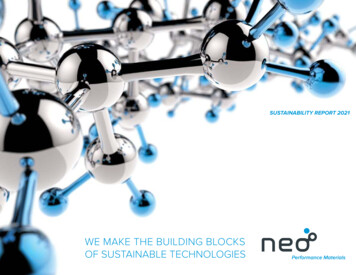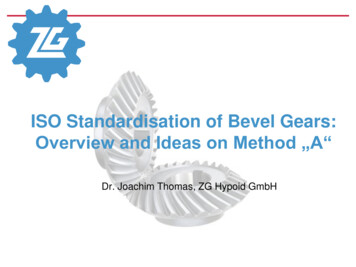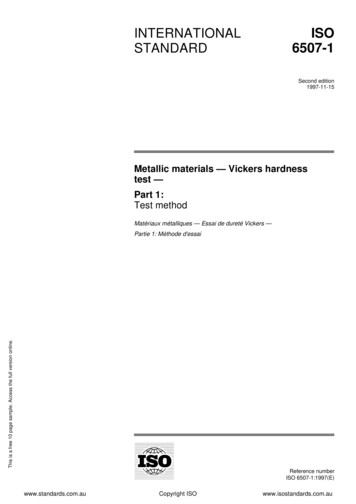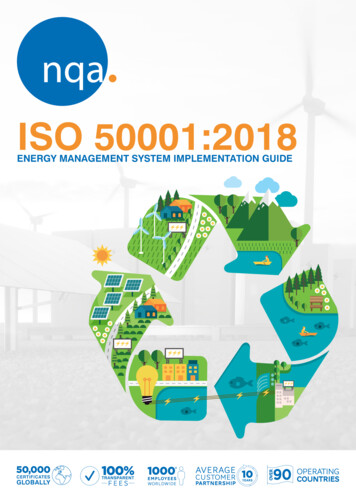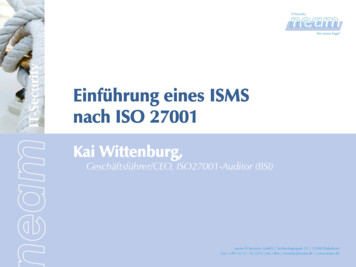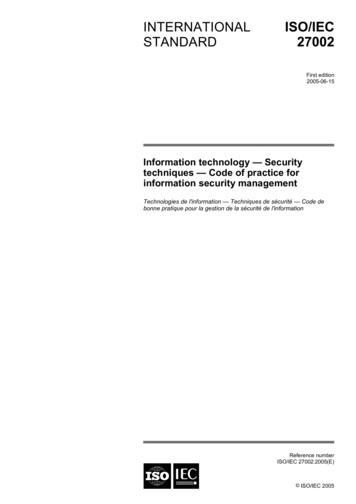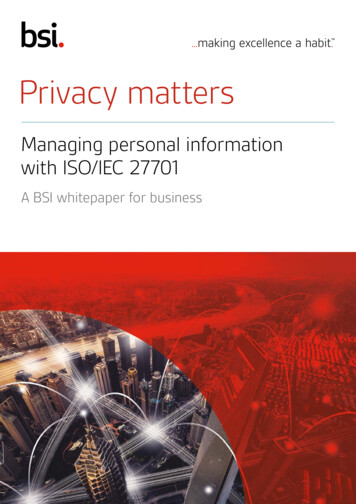
Transcription
Privacy mattersManaging personal informationwith ISO/IEC 27701A BSI whitepaper for business
Privacy mattersIntroductionDigitalization, globalization and personalization of services, from booking a doctor’s appointment to internetbanking, have led to greater collection and processing of personal information than ever before. And thistrend is growing as opportunities for new services arise, and new players enter the market.There are now so many different platforms people use as partof their daily routine where personal information is collectedsuch as the growth in mobile applications, loyalty schemes,connected devices and location-based advertising. This meanswe are regularly handing over our data without thinking itthrough, creating more data flows than ever before. Andwhether it’s dating sites, telecoms providers or public serviceorganizations, there is barely a day that goes by when youlook at the news and don’t see reference to a data breachwhere personal records have been compromised. This hasonly increased the focus on issues surrounding the misuse ofpersonal information, meaning organizations cannot afford tobe complacent.Greater awareness of these issues has led to growing concern,among both individuals and governments, around howpersonal data is collected, used and protected; in response,some governments have proposed or enacted new regulationsaimed at providing guidelines and requirements for treatmentof personal data.Within Europe, the introduction of the General Data ProtectionRegulation (GDPR) provides a harmonization of data privacylaws that reflect the realities of the digital world we now live in.Many other countries, such as Korea, Australia and China, arealso creating data protection legislation. In anticipation of theincreased regulatory environment and a need for a commonset of concepts to address the protection of personal data, theInternational Organization for Standardization (ISO) and theInternational Electrotechnical Commission (IEC) have takenthe initiative to create standards to provide such guidance.These standards have the benefit of providing frameworksfor assisting organizations to demonstrate personal dataprotection and privacy compliance with different laws in achanging regulatory landscape. Certification may also bea useful tool for organizations to add credibility to theircommitment to privacy and related obligations.
bsigroup.comManaging personal informationGiven the dynamic environment in which we operate, the need for guidance on how organizations should manage and processdata to reduce the risk to personal information is getting more important. Guidance, in the form of a new international standard, forhow organizations should manage personal information and assist in demonstrating compliance with updated privacy regulationsaround the world is therefore very powerful. That’s why ISO/IEC 27701 for privacy information management has been developed.What is ISO/IEC 27701?This new international standard is officially calledISO/IEC 27701 (Security techniques — Extension toISO/IEC 27001 and ISO/IEC 27002 for privacy informationmanagement — Requirements and guidelines).As many organizations have implemented an InformationSecurity Management System (ISMS) based on ISO/IEC 27001and using the guidance from ISO/IEC 27002, it’s a natural stepto provide guidance for the protection of privacy that builds onthis strong foundation.ISO/IEC 27701 is a privacy extension to ISO/IEC 27001 andISO/IEC 27002 and provides additional guidance for theprotection of privacy, which is potentially affected by thecollection and processing of personal information. Thedesign goal is to enhance the existing ISMS with additionalrequirements in order to establish, implement, maintain andcontinually improve a Privacy Information Management System(PIMS). The standard outlines a framework for personallyidentifiable information (PII) controllers and PII processors tomanage privacy controls so that risk to individual privacy rightsis reduced (see Table 1). These additional requirements andguidance are written in such a way that they are practical andusable by organizations of all sizes and cultural environments.Table 1 – Personal information management rolesPII ControllerPII ProcessorCollects personal information and determines thepurposes for which it is processed.Processes personal information on behalf of and onlyaccording to the instruction of the PII controller.More than one organisation can act as PII controller oftenknown as co-controller, and this is where data-sharingagreements may be necessary.How ISO/IEC 27701 helps PII ControllersHow ISO/IEC 27701 helps PII Processors Provides best practice guidance Provides best practice guidance Gives transparency between PII controllers Gives reassurance to customers that PII iseffectively managed Provides an effective way to manage PII processes3
Privacy mattersISO/IEC 27701 developing the standardISO/IEC 27701 was drafted by the ISO/IEC Working Group responsible for ‘Identity Management and Privacy Technologies’. Itsdevelopment was led by a BSI-nominated Project Editor and BSI was appointed by the UK Government as the National StandardsBody and represented the UK interests at both the ISO and the IEC.It’s intended that organizations will certify to ISO/IEC 27701 as an extension to ISO/IEC 27001 management system. In other words,organizations planning to seek an ISO/IEC 27701 certification will also need an ISO/IEC 27001 certification. This demonstratescommitment to both information security and privacy management.How ISO/IEC 27701 fits inRequirements and guidance for the protection of personalinformation vary depending upon the context of theorganization and where national laws and regulations areapplicable. ISO/IEC 27001 requires that this context beunderstood and taken into account. ISO/IEC 27701 gets morespecific. It includes mappings to: the privacy framework and principles defined inISO/IEC 29100 ISO/IEC 27018 and ISO/IEC 29151, which both focus on PIIHowever, all these mappings need to be interpreted to takeinto account local laws and regulations. It is also worth notingthat ISO/IEC 27701 is applicable to all organizations that actas processors, controllers or both; ISO/IEC 27018 appliesspecifically to public cloud providers.BS 10012:2017 A1:2018* is a published standard specific tothe UK. It provides a best practice framework for a personalinformation management system that is aligned to theprinciples of the European Union (EU) GDPR. One of the keydistinctions between ISO/IEC 27701 and BS 10012 is thatISO/IEC 27701 is structured so that the PIMS can be consideredan extension to ISMS requirements and controls.ISO/IEC 27701 can be used by PII controllers (including thosewho are joint PII controllers) and PII processors (includingthose using subcontracted PII processors).An organization complying with the requirements inISO/IEC 27701 will generate documented evidence of how ithandles the processing of personal information. This evidencemay be used to facilitate agreements with business partnerswhere the processing of personal information is mutuallyrelevant. This might also assist in relationships with otherstakeholders. The use of ISO/IEC 27701 in conjunction withISO/IEC 27001 can, if desired, provide independent verificationof this evidence, although compliance with these documentscannot be taken as compliance with laws and regulations.Benefits of ISO/IEC 27701 Gives transparency between stakeholdersHelps build trustProvides a more collaborative approachMore effective business agreementsClearer roles and responsibilitiesReduces complexity by integrating withISO/IEC 27001*An amendment to BS10012:2017 was published 2018 (BS 10012 A1:2018).This amendment covers minor changes to some clauses of BS10012:2017;these changes have been made to reflect the UK Data Protection Act 2018.
bsigroup.comTo validate that the adequate operational controls from thestandard are implemented consistently, to carry out thecompliance requirements of relevant privacy regulations,measures must be taken to:1.2.3.map the relevant regulatory requirements against thestandards controlsenumerate specific regulatory requirements that are notalready fully captured by the standard controls and theconditions to which the requirements become applicableincorporate the above into the risk assessment process inthe audit cycleA good example to examine is the data breach managementcontrols in ISO/IEC 27701 and the breach notificationrequirements (article 33) in GDPR. By all measures, thestandard’s security incident management controls mappingsquarely with the GDPR data breach requirements. But thestandard does not contain a specific 72-hour notificationas required by the law. In order for the practitioners todemonstrate that the organization has implemented amanagement system that fulfils this particular GDPRrequirement, they must show the auditors that theorganizations either have a uniform process in place thatwould notify the data subjects and the privacy regulators within72 hours of breach confirmation or has a process to determineif the breach involves European citizens or if the breacheddata processing took place in Europe and, if so, trigger thenotification within the required timeframe.The mapping of standard against regulations and enumeratingof unique regulatory requirements and applicable conditionsare the necessary mechanisms to which controllers andprocessors can use ISO/IEC 27701 to verify regulatorycompliance against multiple privacy regulations.5
Privacy mattersData privacy lawsAs the challenge increases for organizations to keep datasecure and minimize the risk of a breach, it’s unsurprisingto see privacy laws evolving to keep up with the changingbusiness landscape. Most notably, the EU GDPR has receiveda lot of attention.The GDPR is EU law for the preservation of fundamental rightsand freedoms that everyone has the right to the protection ofpersonal information concerning them. These rights must alsobe preserved in respect of data processing activities and thefree flow of personal information between EU Member States.The processing of data should be for the benefit of the naturalpersons that the data belongs to. Similar laws exist aroundthe world to protect the personal information and rights ofcitizens, including some sector-specific requirements such ashealthcare, retail and banking.Healthcare sectorAs a sector that collects some of the most sensitive personal information, healthcare-specific data protectionlaws are very prominent. For example, there is the French Public Health Code (Article L.1111-8) that requiresservice providers who host certain types of health/medical data to be accredited for this activity. And the HealthInsurance Portability and Accountability Act in the United States sets the standard for sensitive patient dataprotection and requires U.S. health plans, healthcare clearing houses and healthcare providers, or any organizationor individual who acts as a vendor or subcontractor with access to personal health information, to comply.It is also important to highlight the European Digital SingleMarket. This is a policy, announced in 2015, that covers digitalmarketing, e-commerce and telecommunications. It aims toopen up opportunities for people and businesses, breakingdown existing barriers. It has three core pillars: Access to online products and services Conditions for digital networks and services togrow and thrive Growth of the European digital economyIt facilitates cross-border data processing and commerce.However, differences in data privacy laws across memberstates of Europe were recognized as a barrier to the EuropeanDigital Single Market being a success. Therefore, theintroduction of GDPR to help harmonize data privacy acrossall of Europe is a positive step change.
bsigroup.comCertification mechanisms to help demonstratecompliance with data protection lawsThe GDPR encourages data protection certificationmechanisms and data protection seals and marks to beestablished to help demonstrate compliance with theregulations of processing operations by controllers andprocessors (GDPR (EU) 2016/679, Article 42). Plus, suchcertification or seals can be used to show that an organizationhas taken the right measures to handle personal information ina way that aligns with the GDPR.Consistent certification mechanisms can bring the allimportant ‘accountability’ factor into the picture, facilitatingthe reduction of risk and improving the free flow of personalinformation. This helps organizations provide useful services,whilst increasing transparency of the process and showingintegrity to customers on the protection of personalinformation as illustrated in Figure 2.It also brings to the surface the importance of data processingto supply chain management, as the controller is responsiblefor the data from cradle to grave. Consider a product suchas a credit card that is co-branded by an airline and a bank.Customer information from both sides would need to beexchanged to identify which customers are likely to takeup such a product. The exchange of a customer’s personalinformation introduces a risk. How does each side verify thatthe other will adequately protect their customer’s data? Therisk is exacerbated as further players are involved. A marketingcompany may be contracted to target customers, perhapseven buying adverts on a social media platform. A cloud servicemight also be used by the marketing company to store andprocess data related to this marketing campaign. Certificationcan serve as an independent verification that will prove theeffectiveness of the process and controls the organization usesto assess the risk of exchanging personal information betweenorganizations throughout the supply chain.However, as depicted in Figure 2(a), if one organization usesa certification scheme in one jurisdiction, and another iscertified to a different scheme that is applicable in anotherjurisdiction, this may not provide the necessary assurance orlevel of trust to business partners that personal informationbelonging to their customers is being properly treated. Giventhe global nature of business, a consistent and uniformassurance mechanism is required to show that organizationscomply with regulations, protecting personal informationand providing an enabler for business growth as depicted inFigure 2(b). A common GDPR certification recognized acrossjurisdictions and industry verticals is necessary to mitigate riskand lower barriers to trade between commercial partners.7
Privacy mattersFigure 2 – Enabling commerce through consistent data privacy certification mechanisms.(a) Fragmented certification between organizations.(b) Consistent certification
bsigroup.comThis sentiment is echoed by the European Union Agency forNetwork and Information Security (ENISA) which recentlypublished recommendations on certification for GDPR [ENISA:Recommendation on European Data Protection Certification,Version 1.0, November 2017; ations-on-european-data-protectioncertification]. ENISA state that certification, seals and markshave a significant role to play in enabling data controllersto achieve and demonstrate compliance of their processingoperations with GDPR provisions. ENISA recommends thatnational certification bodies and supervisory authorities underthe guidance and support of the European Commission andEuropean Data Protection Board should pursue a commonapproach on inception and deployment of GDPR certificationmechanisms. They also recommend that the approach isscalable and uses approved and widely adopted criteria.Consistency and harmonization of certification mechanismsacross Europe are emphasized, and the trustworthinessand transparency are reinforced as important traits of thecertification process.ISO/IEC 27701 is a potential certification mechanismISO/IEC 27701 addresses the recommendations above, andit’s anticipated, could be used as the basis of a certificationmechanism (as stipulated by Article 42). If used in such a way,it would provide the necessary proof that an organizationtreats the personal information of its customers in compliancewith the law, including for the case of cross-border data flows.ISO/IEC 27701 is applicable to organizations of all sizes andcultural environments. It is for the collection and processingPII of both employees and customers. The set of controlsbeing developed extends technical measures for implementinginformation security to also address privacy requirements and,if implemented by an organization, can assist in demonstratingcompliance with data privacy laws such as GDPR.Therefore, demonstrating compliance with the controls inISO/IEC 27701 and generating the required documentation asevidence of how an organization handles PII can: significantly reduce compliance workloads by negating theneed to support multiple certifications increase trust between organizations and customers bydemonstrating compliance with data privacy laws generate evidence that Data Protection Officers can provideto senior management and board members to show theirprogress in privacy regulatory compliance increase the opportunities for business and commercethrough the EU Digital Single Market and cross-borderdata flowsFurthermore, the intended application of ISO/IEC 27701 is toaugment the existing ISMS with privacy-specific controls andcreate a PIMS that enables effective privacy managementwithin an organization. With a well-established network ofauditors providing certification against ISO/IEC 27001, which iscommonly accepted as a successful standard for informationsecurity, ISO/IEC 27701 is in a very good position to beintegrated into existing audit processes.ISO/IEC 27701 was developed through recognized consensusdriven processes; this is one of the key tasks in developing thestandard. There has been input and review from a range ofindustry and regulatory stakeholders; this includes participationand review by the European Data Protection Board (previously,the Article 29 Working Party), consisting of Data ProtectionAuthorities (DPA) from all EU countries. DPAs, as well asaccreditation bodies for auditors, will need to be satisfied thata certification mechanism based on ISO/IEC 27701 adequatelyassists organizations from all industry sectors and of allsizes to demonstrate compliance with privacy regulations.Additionally, a certification mechanism must address the needsof controllers and processors, both of which have numerouscontrols defined for them in ISO/IEC 27701.9
Privacy MattersImportance of stakeholder engagementAs previously mentioned above, ISO/IEC 27701 is an extensionto ISO/IEC 27001, and the standard is structured in the ISOmanagement systems convention (commonly referred toas ‘Annex SL’), allowing multiple management systems to beimplemented more efficiently by an organization. Figure 3shows the landscape of stakeholders and the importance oftheir roles. By already working with the existing ISO/IEC 27001ISMS, all these stakeholders will be in a very good position towork with ISO/IEC 27701. They all share common objectiveson personal information management and the need for arecognized approach to show it is being taken seriously, whichis where the role of ISO/IEC 27701 comes in.Figure 3 – Stakeholder landscape for certification based on ISO/IEC 27701 (source: Microsoft).Implement PIMSHelp the DPA and Nationalaccreditation authorities carryout GDPR articles 42 and 43ProcessorsConsultantsCommon objectivesImplement PIMS Demonstrate the visibility of PIMS in scale across the market. Encourage to adopt pan-European GDPR certification. Demonstrate to the market that PIMs holds up as acomprehensive GDPR evidence set.Initiate and carry outcertification processesAuditorsDPAsControllersProvide a network of accreditedAuditors and Consultants to assureconsistent baseline across Europeand the World
bsigroup.comConclusionsTo conclude, managing personal information in compliance with the evolving regulatorylandscape is complex but cannot be ignored. The protection of an individual’s personalinformation is one of their fundamental human rights. Laws exist around the world toprotect these rights in an environment where business and data related to personal livesare becoming increasingly globalized. The European GDPR has been introduced to ensurethat collection and processing of PII are conducted lawfully, and it supports the crossborder data flows required to enable the EU Digital Single Market.The European GDPR recognizes that certification mechanisms for demonstratingcompliance with regulations go a long way to increasing trust in how organizationstreat personal data, whilst creating business opportunities through providing assurancebetween organizations. This is especially true if certification is implemented consistentlybetween EU member states and beyond the borders of Europe to enable globalcommerce and business.The introduction of ISO/IEC 27701 is a necessary addition to the existing standardsportfolio. Implementing the controls specified in ISO/IEC 27701 should enable anorganization to document evidence on of how it handles the processing of personalinformation. Such evidence may be used to facilitate agreements with business partnerswhere the processing of personal information is mutually relevant and in the eventof gaining a widely accepted certification mechanism, can assist in demonstratingcompliance with data protection laws such as GDPR.11
Privacy MattersWorking with over 86,000 clients across 193 countries, BSI is a truly international business with skills and experienceacross a number of sectors including automotive, aerospace, built environment, food, and healthcare. Through its expertisein Standards Development and Knowledge Solutions, Assurance and Professional Services, BSI improves businessperformance to help clients grow sustainably, manage risk and ultimately be more resilient.Our products and servicesKnowledgeAssuranceComplianceThe core of our business centres onthe knowledge that we create andimpart to our clients.In the standards arena we continueto build our reputation as an expertbody, bringing together experts fromindustry to shape standards at local,regional and international levels.In fact, BSI originally created eightof the world’s top 10 managementsystem standards.Independent assessment of theconformity of a process or productto a particular standard ensures thatour clients perform to a high levelof excellence. We train our clientsin world-class implementation andauditing techniques to ensure theymaximize the benefits of standards.To experience real, long-term benefits,our clients need to ensure ongoingcompliance to a regulation, marketneed or standard so that it becomesan embedded habit. We provide arange of services and differentiatedmanagement tools which helpfacilitate this process.Find out more aboutISO/IEC 27701 with BSIBSI UK389 Chiswick High RoadLondon W4 4ALUnited KingdomT: 44 345 086 9001E: cservices@bsigroup.combsigroup.comCall 0345 080 9000or visit bsigroup.com/iso27701-UK 2019 The British Standards Institution. All Rights Reserved.BSI has been at the forefront of information security standards since 1995, having produced the world’s first standard,BS 7799, now ISO/IEC 27001, the world’s most popular information security standard. And we haven’t stopped there,addressing the new emerging issues such as privacy, cyber and cloud security. That’s why we’re best placed to help youBSI/UK/1591/SC/0719/EN/GRPWhy BSI?
ISO/IEC 27701 (Security techniques — Extension to ISO/IEC 27001 and ISO/IEC 27002 for privacy information management — Requirements and guidelines). As many organizations have implemented an Information Security Management System (ISMS) based on ISO/IEC 27001 and using the guidance from ISO/IEC 27002, it's a natural step

